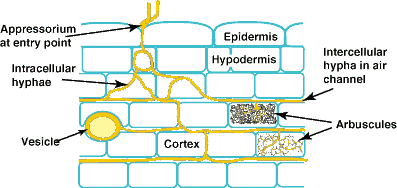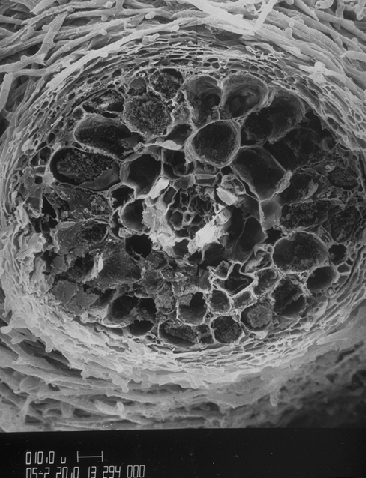

| Definition | ||
Mycorrhizae are symbiotic associations that form between the roots of most plant species and particular fungi. These associations can help plants establish themselves, reach a lower water table or more nutrients than their roots alone could meet, and greatly help in phosphorus uptake in soils where phosphorus is in high demand. Though the benefits reaped by the plant through the symbiotic relationship seem to outweigh those experienced by the fungus – the colonizing fungus does benefit however from the the plant-produced carbon it receives through the roots. The term mycorrhiza, or fungus-root, was first applied to fungus-tree associations in 1885. Since then, studies have estimated that 95% of all plant species belong to genera that characteristically form mycorrhizae. Mycorrhizal associations vary widely in form and function. Though the majority of plant species have associations with mycorrhizal fungi, there are four different types of associations with distinct growth patterns and plant families or genera with which they associate. The most common associations are ectomycorrhizal and arbuscular, which is both ecto and endo mycorrhizal – (meaning that that the fungi grow on the outside as well as on the inside of the plants roots).
Ectomycorrhizal: this type grows between root cortical cells. Ectomycorrhizal fungi can produce hyphae on the root and soil that aid in absorption and movement of nutrients. These hyphae or Hartig net (mantle) can bridge nutrient depletion zones and reach lower water tables. Ectomycorrhizae are found on woody plants ranging from shrubs to forest trees, often found in the families Pinaceae, Fagaceae, Betulaceae, and Myrtaceae.
Arbuscular: this type is often found in warmer, drier environments such as grasslands where nutrient use is high. Arbuscules (little trees) are formed within the cortical cells while hyphae are also found on the root and can help increase the phosphorus inflow rates for the colonized plant. AM is very common and colonizes a great range of both herbaceous and woody plants, indicating a lack of host specificity. In turn, the effective impact of AM ranges as well.
Ericaceous: this type of mycorrhiza is associated with ericaceous plants (of the Ericales order). The fungus grows extensively within the cortical (core) cells with very little extension into the soil. The fungus aids the plant with extracellular enzymes the break down organic matter. Orchidaceous: this mycorrhizal association is unique to the Orchidaceae family. The plant is colonized shortly after germination The fungus supplies carbon and vitamins to the developing embryo. (Some plants such as Alnus, Salix, Populus, and Euclayuptus can have both arbuscular and ectomycorrhizal associations on the same plant.) In general, it's important to understand that there are different types of mycorrhizal fungi and that these different types form different relationships with different plants – not all mycorrhizal associations are the same. |
||


